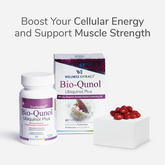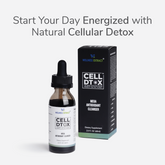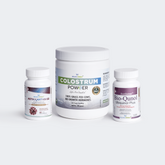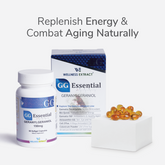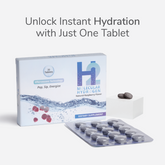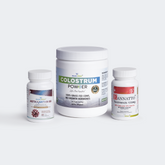Estimated Reading Time: 14 minutes
|In the history of essential nutrients, vitamin E has ruled the crown forever. But do you know vitamin E is not a single nutrient? Instead, it is a collective name of fat-soluble compounds with distinctive antioxidant capabilities. Earlier known only for tocopherols, the vitamin E family also includes the more potent tocotrienols, which exist in four isomeric forms.
Although tocotrienols were discovered much later than tocopherols, they offer remarkable health benefits that their 'older siblings' lack. Research suggests that tocotrienols may support brain health, lower cholesterol levels, and possess anticancer properties. However, since human trials are still limited, there's much we don't know. And that's why tocotrienols deserve a closer scientific look.
What is tocotrienols vitamin E, who discovered it, and how? Most importantly, why might tocotrienols be more potent than tocopherols, even though tocopherols have been known for much longer?
Here in this blog, you will learn everything about tocotrienols based on existing studies and research.
Why Scientists Took So Long to Notice Tocotrienols
The discovery of tocopherols is widely known. Evans and Bishop discovered it as a dietary fertility factor in rats in 1922. But do you know who discovered tocotrienols? You might be surprised to learn that scientists initially misunderstood tocotrienols. Yes, you heard it right! Until the 1960s, tocotrienols were mislabeled as tocopherols due to their structural similarities.
Later, in 1964, Pennock and Whittle first discovered and described the isolation of tocotrienols from rubber plants. By 1980-90, with scientific advancements, scientists had identified eight different forms of vitamin E. Alpha, beta, gamma, and delta isomers of both tocopherols and tocotrienols!

What Makes Tocotrienols Superior
Both tocotrienols and tocopherols are known for their antioxidant properties. Then what makes tocotrienols a unique member of the vitamin E family? It's the 'tail' of the molecule that creates the whole difference.
Tocotrienols have a molecular formula, C27H40O2, that is quite similar to that of tocopherols, C29H50O2.
However, unlike tocopherols, tocotrienols have an unsaturated side chain with three C=C. The presence of three double bonds pulls the carbon atoms together, reducing the bond length compared to the single bonds. In simple words, the side chain of vitamin E tocotrienols is shorter compared to that of tocopherols, which impacts its effectiveness.
Studies support that double-bond positioning and isomerism can significantly influence mobility and lipid ion interaction. With their shorter side chain, tocotrienols can penetrate deeper into lipid membranes, combating oxidative stress, even in the regions that tocopherols might miss. According to recent research, tocotrienols are 40-60 times more potent antioxidants than tocopherols.
Isomeric Forms of Tocotrienols
Tocotrienols exist in four isomeric forms: alpha, beta, gamma, and delta. Let's see how they are different from each other.
Alpha-tocotrienol
α-tocotrienol has three methyl groups attached at 5, 7, and 8 positions. It is the most bioactive form of vitamin E tocotrienols, found in plasma and lipoproteins.
Beta-tocotrienol
β-tocotrienol contains two methyl groups at 5 and 8 structural positions. It is found in vegetable oils, nuts, and grains.
Gamma-tocotrienol
γ-tocotrienol has two methyl groups attached at the 7 and 8 structural positions. After delta-form, it is the best-known tocotrienol antioxidant.
Delta-tocotrienol
δ-tocotrienols are known for their anticancer properties and are one of the most potent antioxidant isomers of tocotrienol. It has a single methyl group, which is responsible for its high antioxidative properties.

So, does that mean tocotrienols and tocopherols aren't related at all?
Hold on! Despite their structural differences, tocotrienols and tocopherols share key similarities in function. Both vitamin E siblings consist of a chromanol ring, which is responsible for the antioxidation. Further, tocotrienols and tocopherols follow the same mechanism of action for combating oxidative stress. Let's see what is tocotrienols' exact mechanism of action.
Tocotrienol As A Potent Antioxidant: Mechanism of Action
Tocotrienols are powerful defenders against oxidative stress. Wondering what's the secret? Chromanol group and the flexible side chain.
Chromanol Group
The presence of a hydroxyl group (-OH) on an aromatic ring makes it easier for tocotrienol to donate a hydrogen atom, facilitating the reduction process. It readily donates electrons to free radicals, neutralizing them. Free radicals are highly unstable molecules with unpaired electrons. They often react with DNA cells, affecting their metabolism. By scavenging free radical activity, tocotrienols protect cells from oxidative stress.
Flexible Side Chain
Tocopherols also contain a chromanol group, which helps in inhibiting lipid peroxidation. However, the difference is that tocopherols are less flexible. The alkane side chain makes it impossible to penetrate deeper into the cell membranes, especially when it comes to thick lipid layers like the one present in the heart and brain. Thus, beyond essential oxidation protection, tocotrienols can also be beneficial in supporting cardiovascular and brain health. Given these advantages, the next question is—where can tocotrienols be obtained from?
Where Can You Get Tocotrienols Naturally
Unlike tocopherols, vitamin E tocotrienols have a rare natural presence. In most vitamin E food sources, like leafy vegetables and nuts, tocopherols are present in abundance. Latex of the rubber plant was the first source that indicated the presence of the tocotrienols. However, the distribution was uneven, with tocopherols having the majority.
Later, Dr. Barrie Tan, the world's foremost expert on vitamin E, discovered tocotrienols in palm oil and rice bran. Palm oil contains 70% of tocotrienols, and rice bran contains just about 60% of this potent antioxidant. In 2002, Dr. Barrie made a breakthrough discovery by identifying tocotrienols in annatto seeds. To this day, annatto remains the only known natural source that contains little to no tocopherols. On average, annatto seeds contain more than 90% of delta tocotrienols. Currently, there are annatto-derived vitamin E tocotrienol supplements for those struggling with the deficiency.

Health Benefits of Tocotrienols As Potent Antioxidants
Our bodies produce free radicals as a result of metabolic processes and environmental factors, majorly when oxygen is consumed for energy generation. In terms of chemistry, these free radicals are unstable molecules created when an atom or molecule gains or loses an electron. With an unbalanced electron, free radicals remain highly reactive.
At low levels, free radicals are beneficial for the body. They help with cellular responses and immune function. However, at higher levels, free radicals interfere with cellular function and metabolism. They can lead to oxidative stress, damaging cells and leading to chronic diseases such as diabetes, cancer, and even cardiovascular risks.
However, the good news is that the human body can combat oxidative stress by producing or taking antioxidants. Annatto-derived vitamin E tocotrienols are one of the most potent antioxidants that individuals may take in food or supplements. It can neutralize free radicals more effectively than any other vitamin E form, promoting overall cellular growth. Everyone can't consume annatto in its natural form (including paste, seeds, and annatto extract) due to demographic barriers. However, it is still possible for everyone to access GRAS-certified tocotrienol supplements to get the health benefits of tocotrienols.
Learn: The Science Behind Tocotrienol's Super Speed in Fighting Free Radicals
Advantage of Tocotrienol Supplementation: Beyond Antioxidation
If you think that all tocotrienol supplements can do is protect your body from lipid peroxidation, you might be jumping too quickly into results. Currently, tocotrienols are gaining significant attention worldwide due to their potential health benefits. Studies support tocotrienol as a neuroprotective compound that even exhibits anticancer benefits. However, human trials based on these potentials are still limited, causing a serious debate about the accurate mechanisms and results. Let's consider what scientific evidence says about the potential health benefits of tocotrienols.
Fights Inflammation
Chronic cellular inflammation in the body can contribute to tissue damage and severe health risks, including diabetes and cancer. In studies, tocotrienols have successfully suppressed pro-inflammatory pathways, including cyclooxygenase and lipoxygenase, that promote inflammation and pain.
Additionally, tocotrienols may inhibit nuclear factor kappa B (NF-κB), which controls the production of cytokines like IL-6, TNF-α, and IL-1β, driving chronic damage. With its antioxidative properties, tocotrienol prevents free radical-induced inflammation. Thus, tocotrienol vitamin E can contribute to overall cellular health.
Supports Brain Health
The nervous system is one of the vital organ systems responsible for the control and coordination of the human body. And tocotrienols can offer neuroprotective benefits. In an experiment, astrocytes treated with 180 mM glutamate experienced significant cell death. However, with tocotrienol treatment, astrocytes have shown improved cell viability.
Thus, tocotrienols may combat glutamate toxicity primarily by mitigating oxidative stress. Additionally, tocotrienols also support cellular energy production by maintaining mitochondrial integrity. It may support overall brain health by preventing cell death pathways associated with mitochondrial dysfunction.
Lowers Cholesterol
Well, this is one of the most unique properties of tocotrienols that tocopherols lack. In the 1980s, tocotrienols were first reported to lower cholesterol levels. Studies suggest that tocotrienols can inhibit the hepatic enzyme HMG-CoA reductase, which is responsible for cholesterol production.
And do you know what's more interesting? Not only do tocopherols lack the ability to lower cholesterol, but they also counteract the effects of tocotrienols. This might be because α-tocopherol has been observed to induce enzymatic activity of HMG-CoA reductase. That's why tocotrienols are considered superior to their siblings.
Running from high cholesterol? See how you can control cholesterol levels through diet.
Cancer-Preventive Activities
One of the recent buzzes around tocotrienols is that it may be an adjuvant anticancer treatment. Even in clinical studies, tocotrienols have suppressed the growth of various cancer cell types, including pancreatic and prostate cancer. You might be wondering how that's even possible.
Tocotrienols may promote apoptosis, thereby preventing cancer cells from multiplying. Further, tocotrienols may also inhibit angiogenesis, the formation of new blood vessels that supply nutrients to tumors. Though there is less human-based evidence right now, in the coming times, tocotrienols may turn into promising agents in cancer prevention and therapy.
Strengthens Bones
Osteoclasts are associated with the destruction of bone cells. While they are essential for making space for osteoblasts to create new bone tissues, excessive osteoclasts can cause severe bone disorders, including osteoporosis and rheumatoid arthritis. In studies, tocotrienols have suppressed the formation of osteoclasts and also reduced their bone-resorbing activity.
Additionally, tocotrienols may modulate the expression of Receptor Activator of Nuclear Factor Kappa-Β Ligand (RANKL) and Osteoprotegerin (OPG), two critical regulators of bone remodeling. By decreasing RANKL levels and/or increasing OPG levels, tocotrienols may help inhibit osteoclastogenesis, thereby promoting bone formation and improving bone health.
Slows Skin Aging
If you are looking for a natural way to embrace your signs of aging, tocotrienols can be your savior. Research supports that vitamin E tocotrienols can protect skin from UV-induced oxidative stress. Tocotrienols can mitigate DNA damage and reduce sunburns.
Additionally, tocotrienols have been found to downregulate tyrosinase activity, the key enzyme for melanin production. By regulating melanin synthesis, it may reduce hyperpigmentation and age spots. As per recent research, topical application of tocotrienols strengthens the skin barrier function by improving skin hydration.
Promotes Hair Growth
In a clinical trial, participants with tocotrienol supplementation have shown significant hair growth. After 8 months of continuous tocotrienol supplementation, the group has shown about a 34.5% increase in hair count. However, there was no significant change in the cumulative weight of hair clippings, suggesting that the hair thickness and density of individuals remain unchanged.
Thus, in the near future, we may assume that tocotrienols can help with the condition of scalp alopecia. Though still unclear, the primary mechanism of action behind this is the ability of the tocotrienols to combat lipid peroxidation, which creates a favorable environment for hair growth.
Lesser-Known Therapeutic Benefits Of Tocotrienols
Beyond the above-mentioned health benefits of tocotrienols, there is some other lesser-known therapeutic potential, including:
Protection Against NAFLD
Nonalcoholic fatty liver disease (NAFLD) affects millions of people worldwide, with an estimated global prevalence of 32% among adults. Inflammation and oxidative stress are the primary contributors to NAFLD. Tocotrienols, which are more potent antioxidants than alpha-tocopherol, may help support NAFLD management.
An animal-based study shows that tocotrienols can reduce liver steatosis by regulating lipid metabolism. It also decreases inflammatory responses, preventing liver fibrosis and promoting hepatic health.
Supports Ocular Health
Tocotrienol vitamin E, with its antioxidant and anti-angiogenic properties, may support ocular health. In animal studies, topical application of tocotrienols delayed the onset and progression of cataracts.
Additionally, tocotrienols have been shown to inhibit angiogenesis, which can lead to vision loss by stimulating age-related macular degeneration (AMD). In AMD, the central part of the retina called the macula, is damaged. It thus affects the vision and ability to see fine details. When left unnoticed for the long term, people may lose their ability to drive or read smaller print.
Gastroprotective Effects
In a rat-based clinical trial, tocotrienols have exerted comparable effects as omeprazole, a popular proton pump inhibitor. Rats, when administered 60 mg/kg of tocotrienol or all, have significantly reduced the lesion index compared to the stressed control group.
Unlike omeprazole, tocotrienols upregulate growth factors, including vascular endothelial growth factor (VEGF), transforming growth factor-alpha (TGF-α), and basic fibroblast growth factor (bFGF), that facilitate the repair of gastric tissue injuries. Thus, it may help with gastric ulcers. However, these studies are solely based on animal trials and lack human compatibility.
Metabolic Disease Protection
Tocotrienols vitamin E may help in managing metabolic conditions such as obesity and type 2 diabetes. Studies support that tocotrienols may inhibit the differentiation of preadipocytes into mature fat cells. Thus, reducing fat accumulation may help manage excess body weight.
Additionally, it is observed that tocotrienol can improve glucose homeostasis by enhancing insulin sensitivity. Thus, tocotrienol supplementation may help with glucose metabolism. However, there is still some uncertainty. While animal studies have demonstrated promising results, human clinical trials have yielded mixed outcomes.
Now that the benefits of tocotrienols are clear, the next question is—how can they be taken for maximum effectiveness?
Taking Tocotrienols Supplement
You can take tocotrienol supplements in softgel capsules to ensure their maximum bioavailability at cellular levels. While it is okay to take the supplements anytime you want, it is best to take them with meals for better absorption.
Who Should Consider Tocotrienols Supplements
Vitamin E tocotrienols are definitely beneficial for individuals diagnosed with vitamin E deficiency. Additionally, tocotrienol supplementation can also be helpful for people with certain health conditions, including NAFLD, GIT issues, and cardiovascular risks. You can also include tocotrienols supplements if you want to support skin and hair health.
Note: Pregnant or lactating women or individuals should pay attention and not overtake the tocotrienols. Always consult a medical professional to determine the right way to add tocotrienols to your routine and find the ideal dosage for your needs.
Ideal Dose of Tocotrienols
When consumed in the recommended and ideal dose, tocotrienols are safe for most individuals. Recently, the FDA has also granted GRAS status to tocotrienol supplements. There is no FDA or WHO statement about the ideal dose of tocotrienols. Most of the websites and physicians suggest 200-600 mg of tocotrienols as an ideal dosage per day. However, 1000 mg of tocotrienol per day is generally considered tolerable.

Learn More: Right Tocotrienol Dosage & Nutrient Pairings for 13 Key Health Benefits
Are There Any Side Effects of Tocotrienols Supplements
Most individuals haven't registered any specific side effects while consuming tocotrienols, even at higher doses. However, it is best to consult your doctor if you observe any serious side effects like bleeding, bruising, stomachache, fatigue, or others.
Potential Drug Interactions of Tocotrienols
Tocotrienols are generally safe when taken at an ideal dose. However, according to medical research, you must be careful while taking tocotrienols with certain drugs, including:
Anticoagulant Drugs
Higher doses of tocotrienol vitamin E (≥300 mg/day) may interfere with blood-thinning medications like warfarin and aspirin. It may enhance its mechanism of action, increasing the risk of bleeding.
Antiestrogen Drugs
Anti-estrogen drugs like Tamoxifen work by modulating the hormonal balance and are used in breast cancer therapy. Vitamin E supplementation can interfere with the efficacy of such medications. However, one must note that in ideal dosage, it does not harm.
Immunosuppressant Drugs
Tocotrienols vitamin E may affect the pharmacokinetics of immunosuppressant drugs like cyclosporine A, altering its therapeutic levels.
Blood Pressure Drugs
Since tocotrienols may reduce blood pressure naturally, they can enhance the effect of BP-regulating drugs, which may reduce BP too low.
However, you must know that even medical reviews indicate that consumption of vitamin E at relevant doses is generally safe and may not cause adverse interactions with most medications. For further information, it is always best to consult medical recommendations.
Final Words
Undoubtedly, tocotrienols are the ultimate antioxidant compared to other forms of vitamin E. Whether you're getting them through food or high-quality supplements, adding tocotrienols to your routine could contribute to your long-term health. So, have you considered adding them yet? Speak with your doctor to determine the right dosage and take a step toward better well-being today.
Disclaimer: These statements have not been assessed or evaluated by the Food and Drug Administration. The supplements listed above are not intended to diagnose, treat, cure, or prevent any disease. The findings are solely based on preliminary research and ongoing studies. Individual results after trying these health tips and measures may vary.
Sources:
- https://pmc.ncbi.nlm.nih.gov/articles/PMC8301652/
- https://pmc.ncbi.nlm.nih.gov/articles/PMC4333972/
- https://pubmed.ncbi.nlm.nih.gov/11882333/
- https://pmc.ncbi.nlm.nih.gov/articles/PMC2860705/
- https://pmc.ncbi.nlm.nih.gov/articles/PMC6386883/
- https://pmc.ncbi.nlm.nih.gov/articles/PMC6094554/
- https://pmc.ncbi.nlm.nih.gov/articles/PMC9588953/
- https://pmc.ncbi.nlm.nih.gov/articles/PMC9965814/
- https://pmc.ncbi.nlm.nih.gov/articles/PMC3819075/
- https://www.sciencedirect.com/science/article/pii/S2666566224000315
- https://pmc.ncbi.nlm.nih.gov/articles/PMC5583573/
- https://pmc.ncbi.nlm.nih.gov/articles/PMC6429133/
- https://pubmed.ncbi.nlm.nih.gov/25225959/
- https://pmc.ncbi.nlm.nih.gov/articles/PMC4392014/
- https://pmc.ncbi.nlm.nih.gov/articles/PMC4247006/
- https://pubmed.ncbi.nlm.nih.gov/1649783/
- https://nutraceuticalbusinessreview.com/american-river-nutrition-s-deltagold-receives-fda-gras-status-99424
- https://pmc.ncbi.nlm.nih.gov/articles/PMC5775572/
- https://www.researchgate.net/publication/318601954_Tocotrienol_and_tocopherol_contents_of_annatto_seed_accessions
- https://www.e-cmh.org/journal/view.php?number=1748
- https://ods.od.nih.gov/factsheets/VitaminE-HealthProfessional/






















